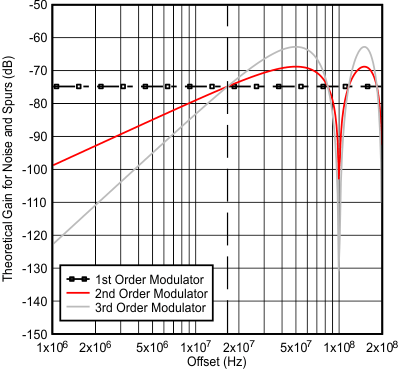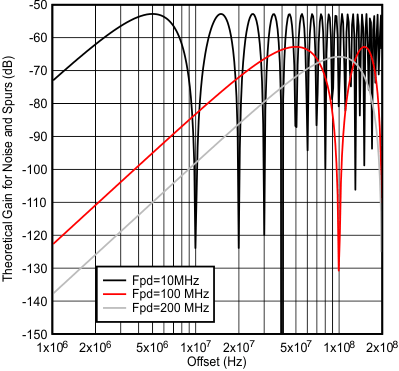SNAS668E August 2015 – September 2024 LMK03328
PRODUCTION DATA
- 1
- 1 Features
- 2 Applications
- 3 Description
- 4 Device Comparison
- 5 Pin Configuration and Functions
-
6 Specifications
- 6.1 Absolute Maximum Ratings
- 6.2 ESD Ratings
- 6.3 Recommended Operating Conditions
- 6.4 Thermal Information
- 6.5 Thermal Information
- 6.6 Electrical Characteristics - Power Supply
- 6.7 Pullable Crystal Characteristics (SECREF_P, SECREF_N)
- 6.8 Non-Pullable Crystal Characteristics (SECREF_P, SECREF_N)
- 6.9 Clock Input Characteristics (PRIREF_P/PRIREF_N, SECREF_P/SECREF_N)
- 6.10 VCO Characteristics
- 6.11 PLL Characteristics
- 6.12 1.8-V LVCMOS Output Characteristics (OUT[7:0])
- 6.13 LVCMOS Output Characteristics (STATUS[1:0]
- 6.14 Open-Drain Output Characteristics (STATUS[1:0])
- 6.15 AC-LVPECL Output Characteristics
- 6.16 AC-LVDS Output Characteristics
- 6.17 AC-CML Output Characteristics
- 6.18 HCSL Output Characteristics
- 6.19 Power-On/Reset Characteristics
- 6.20 2-Level Logic Input Characteristics (HW_SW_CTRL, PDN, GPIO[5:0])
- 6.21 3-Level Logic Input Characteristics (REFSEL, GPIO[3:1])
- 6.22 Analog Input Characteristics (GPIO[5])
- 6.23 I2C-Compatible Interface Characteristics (SDA, SCL)
- 6.24 Typical 156.25-MHz, Closed-Loop Output Phase Noise Characteristics
- 6.25 Typical 161.1328125-MHz, Closed-Loop Output Phase Noise Characteristics
- 6.26 Closed-Loop Output Jitter Characteristics
- 6.27 PCIe Clock Output Jitter
- 6.28 Typical Power Supply Noise Rejection Characteristics
- 6.29 Typical Power Supply Noise Rejection Characteristics
- 6.30 Typical Closed-Loop Output Spur Characteristics
- 6.31 Typical Characteristics
- 7 Parameter Measurement Information
-
8 Detailed Description
- 8.1 Overview
- 8.2 Functional Block Diagram
- 8.3 Feature Description
- 8.4
Device Functional Modes
- 8.4.1 Smart Input MUX
- 8.4.2 Universal Input Buffer (PRI_REF, SEC_REF)
- 8.4.3 Crystal Input Interface (SEC_REF)
- 8.4.4 Reference Doubler
- 8.4.5 Reference (R) Divider
- 8.4.6 Input (M) Divider
- 8.4.7 Feedback (N) Divider
- 8.4.8 Phase Frequency Detector (PFD)
- 8.4.9 Charge Pump
- 8.4.10 Loop Filter
- 8.4.11 VCO Calibration
- 8.4.12 Fractional Circuitry
- 8.4.13 Post Divider
- 8.4.14 High-Speed Output MUX
- 8.4.15 High-Speed Output Divider
- 8.4.16 High-Speed Clock Outputs
- 8.4.17 Output Synchronization
- 8.4.18 Status Outputs
- 8.5 Programming
-
9 Register Maps
- 9.1
LMK03328
Registers
- 9.1.1 VNDRID_BY1 Register; R0
- 9.1.2 VNDRID_BY0 Register; R1
- 9.1.3 PRODID Register; R2
- 9.1.4 REVID Register; R3
- 9.1.5 PARTID Register; R4
- 9.1.6 PINMODE_SW Register; R8
- 9.1.7 PINMODE_HW Register; R9
- 9.1.8 TARGETADR Register; R10
- 9.1.9 EEREV Register; R11
- 9.1.10 DEV_CTL Register; R12
- 9.1.11 INT_LIVE Register; R13
- 9.1.12 INT_MASK Register; R14
- 9.1.13 INT_FLAG_POL Register; R15
- 9.1.14 INT_FLAG Register; R16
- 9.1.15 INTCTL Register; R17
- 9.1.16 OSCCTL2 Register; R18
- 9.1.17 STATCTL Register; R19
- 9.1.18 MUTELVL1 Register; R20
- 9.1.19 MUTELVL2 Register; R21
- 9.1.20 OUT_MUTE Register; R22
- 9.1.21 STATUS_MUTE Register; R23
- 9.1.22 DYN_DLY Register; R24
- 9.1.23 REFDETCTL Register; R25
- 9.1.24 STAT0_INT Register; R27
- 9.1.25 STAT1 Register; R28
- 9.1.26 OSCCTL1 Register; R29
- 9.1.27 PWDN Register; R30
- 9.1.28 OUTCTL_0 Register; R31
- 9.1.29 OUTCTL_1 Register; R32
- 9.1.30 OUTDIV_0_1 Register; R33
- 9.1.31 OUTCTL_2 Register; R34
- 9.1.32 OUTCTL_3 Register; R35
- 9.1.33 OUTDIV_2_3 Register; R36
- 9.1.34 OUTCTL_4 Register; R37
- 9.1.35 OUTDIV_4 Register; R38
- 9.1.36 OUTCTL_5 Register; R39
- 9.1.37 OUTDIV_5 Register; R40
- 9.1.38 OUTCTL_6 Register; R41
- 9.1.39 OUTDIV_6 Register; R42
- 9.1.40 OUTCTL_7 Register; R43
- 9.1.41 OUTDIV_7 Register; R44
- 9.1.42 CMOSDIVCTRL Register; R45
- 9.1.43 CMOSDIV0 Register; R46
- 9.1.44 CMOSDIV1 Register; R47
- 9.1.45 STATUS_SLEW Register; R49
- 9.1.46 IPCLKSEL Register; R50
- 9.1.47 IPCLKCTL Register; R51
- 9.1.48 PLL1_RDIV Register; R52
- 9.1.49 PLL1_MDIV Register; R53
- 9.1.50 PLL2_RDIV Register; R54
- 9.1.51 PLL2_MDIV Register; R55
- 9.1.52 PLL1_CTRL0 Register; R56
- 9.1.53 PLL1_CTRL1 Register; R57
- 9.1.54 PLL1_NDIV_BY1 Register; R58
- 9.1.55 PLL1_NDIV_BY0 Register; R59
- 9.1.56 PLL1_FRACNUM_BY2 Register; R60
- 9.1.57 PLL1_FRACNUM_BY1 Register; R61
- 9.1.58 PLL1_FRACNUM_BY0 Register; R62
- 9.1.59 PLL_FRACDEN_BY2 Register; R63
- 9.1.60 PLL1_FRACDEN_BY1 Register; R64
- 9.1.61 PLL1_FRACDEN_BY0 Register; R65
- 9.1.62 PLL1_MASHCTRL Register; R66
- 9.1.63 PLL1_LF_R2 Register; R67
- 9.1.64 PLL1_LF_C1 Register; R68
- 9.1.65 PLL1_LF_R3 Register; R69
- 9.1.66 PLL1_LF_C3 Register; R70
- 9.1.67 PLL2_CTRL0 Register; R71
- 9.1.68 PLL2_CTRL1 Register; R72
- 9.1.69 PLL2_NDIV_BY1 Register; R73
- 9.1.70 PLL2_NDIV_BY0 Register; R74
- 9.1.71 PLL2_FRACNUM_BY2 Register; R75
- 9.1.72 PLL2_FRACNUM_BY1 Register; R76
- 9.1.73 PLL2_FRACNUM_BY0 Register; R77
- 9.1.74 PLL2_FRACDEN_BY2 Register; R78
- 9.1.75 PLL2_FRACDEN_BY1 Register; R79
- 9.1.76 PLL2_FRACDEN_BY0 Register; R80
- 9.1.77 PLL2_MASHCTRL Register; R81
- 9.1.78 PLL2_LF_R2 Register; R82
- 9.1.79 PLL2_LF_C1 Register; R83
- 9.1.80 PLL2_LF_R3 Register; R84
- 9.1.81 PLL2_LF_C3 Register; R85
- 9.1.82 XO_MARGINING Register; R86
- 9.1.83 XO_OFFSET_GPIO5_STEP_1_BY1 Register; R88
- 9.1.84 XO_OFFSET_GPIO5_STEP_1_BY0 Register; R89
- 9.1.85 XO_OFFSET_GPIO5_STEP_2_BY1 Register; R90
- 9.1.86 XO_OFFSET_GPIO5_STEP_2_BY0 Register; R91
- 9.1.87 XO_OFFSET_GPIO5_STEP_3_BY1 Register; R92
- 9.1.88 XO_OFFSET_GPIO5_STEP_3_BY0 Register; R93
- 9.1.89 XO_OFFSET_GPIO5_STEP_4_BY1 Register; R94
- 9.1.90 XO_OFFSET_GPIO5_STEP_4_BY0 Register; R95
- 9.1.91 XO_OFFSET_GPIO5_STEP_5_BY1 Register; R96
- 9.1.92 XO_OFFSET_GPIO5_STEP_5_BY0 Register; R97
- 9.1.93 XO_OFFSET_GPIO5_STEP_6_BY1 Register; R98
- 9.1.94 XO_OFFSET_GPIO5_STEP_6_BY0 Register; R99
- 9.1.95 XO_OFFSET_GPIO5_STEP_7_BY1 Register; R100
- 9.1.96 XO_OFFSET_GPIO5_STEP_7_BY0 Register; R101
- 9.1.97 XO_OFFSET_GPIO5_STEP_8_BY1 Register; R102
- 9.1.98 XO_OFFSET_GPIO5_STEP_8_BY0 Register; R103
- 9.1.99 XO_OFFSET_SW_BY1 Register; R104
- 9.1.100 XO_OFFSET_SW_BY0 Register; R105
- 9.1.101 PLL1_CTRL2 Register; R117
- 9.1.102 PLL1_CTRL3 Register; R118
- 9.1.103 PLL1_CALCTRL0 Register; R119
- 9.1.104 PLL1_CALCTRL1 Register; R120
- 9.1.105 PLL2_CTRL2 Register; R131
- 9.1.106 PLL2_CTRL3 Register; R132
- 9.1.107 PLL2_CALCTRL0 Register; R133
- 9.1.108 PLL2_CALCTRL1 Register; R134
- 9.1.109 NVMSCRC Register; R135
- 9.1.110 NVMCNT Register; R136
- 9.1.111 NVMCTL Register; R137
- 9.1.112 NVMLCRC Register; R138
- 9.1.113 MEMADR_BY1 Register; R139
- 9.1.114 MEMADR_BY0 Register; R140
- 9.1.115 NVMDAT Register; R141
- 9.1.116 RAMDAT Register; R142
- 9.1.117 ROMDAT Register; R143
- 9.1.118 NVMUNLK Register; R144
- 9.1.119 REGCOMMIT_PAGE Register; R145
- 9.1.120 POR_CTRL Register; R173
- 9.1.121 XOCAPCTRL_BY1 Register; R199
- 9.1.122 XOCAPCTRL_BY0 Register; R200
- 9.2 EEPROM Map
- 9.1
LMK03328
Registers
-
10Application and Implementation
- 10.1 Application Information
- 10.2 Typical Applications
- 10.3 Power Supply Recommendations
- 10.4 Layout
- 11Device and Documentation Support
- 12Revision History
- 13Mechanical, Packaging, and Orderable Information
8.4.12.2 Programmable Delta Sigma Modulator Order
The programmable fractional modulator order gives the opportunity to better optimize phase noise and spurs. Theoretically, higher order modulators push out phase noise to farther offsets, as described in Table 8-5.
| ORDER | APPLICATIONS |
|---|---|
| Integer Mode (Order = 0) | If the fractional numerator is zero, running the PLL in integer mode is best to minimize phase noise and spurs. |
| First Order Modulator | When the equivalent fractional denominator is 6 or less, the first order modulator theoretically has lower phase noise and spurs, and is the preferred choice. When the fractional denominator is between 6 and about 20, consider using the first order modulator because the spurs can be far enough outside the loop bandwidth that the spurs are filtered. The first order modulator also does not create any sub-fractional spurs or phase noise. |
| Second and Third Order Modulator | The choice between 2nd and 3rd order modulator tends to be a little more application specific. If the fractional denominator is not divisible by 3, then the second and third order modulators has spurs in the same offsets, so the third order modulator is typically better for spurs. However, if stronger levels of dithering is used, the third order modulator creates more close-in phase noise than the second order modulator. |
Figure 8-19 and Figure 8-20 provide an idea of the theoretical impact of the delta sigma modulator order on the shaping of the phase noise and spurs. In terms of phase noise, this is theoretically expected if strong dithering is used for a well-randomized fraction. Dithering can be set to different levels or even disabled and the noise can be eliminated. The spurs can change based on fraction, but the spurs can theoretically pushed out to higher phase detector frequencies. The following graphs are just theoretical and for offsets that are less than 5% of the phase detector frequency, other factors can impact the noise and spurs. In Figure 8-19, the curves all cross at 1/6th of the phase detector frequency and that this transfer function peaks at half of the phase detector frequency, which is assumed to be well outside the loop bandwidth. Figure 8-20 shows the impact of the phase detector frequency on the modulator noise.
 Figure 8-19 Theoretical Delta Sigma Noise Shaping for a 100-MHz Phase Detector Frequency
Figure 8-19 Theoretical Delta Sigma Noise Shaping for a 100-MHz Phase Detector Frequency Figure 8-20 Theoretical Delta Sigma Noise Shaping for 3rd Order Modulator
Figure 8-20 Theoretical Delta Sigma Noise Shaping for 3rd Order Modulator